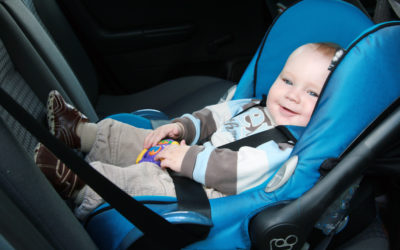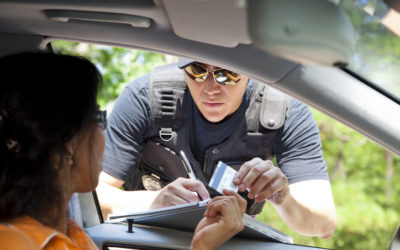Is It Legal to Ride in the Back of Pickup Trucks?
Driving Laws: Is It Legal to Ride in the Back of a Pickup Truck?
Lots of people and pets ride in the back of a pickup truck, many without incident. However, there usually aren’t seat belts in the back. A lack of restraints causes serious personal injuries and factored into 47 percent of fatal accidents in 2017, according to the National Highway Traffic Safety Administration
Still, the question of safety doesn’t quite answer the question, is it legal? There’s no single response to that, though. Here’s all you need to know before riding in the bed of a truck.
Is It Legal to Ride in the Back of a Pickup Truck?
The answer to this question varies, because every state in United States has its own standards — and, sometimes, the rules they set are strange. When it comes to riding in the back of a pickup truck, though, the laws are relatively clear-cut.
The following 19 states don’t have any rules about riding in the bed of a truck. In other words, you won’t get in legal trouble for doing so in:
- Alabama
- Alaska
- Delaware
- Idaho
- Illinois
- Iowa, although local ordinances may prohibit it
- Kentucky
- Minnesota
- Mississippi
- Montana
- New Hampshire
- North Dakota
- Oklahoma
- South Dakota
- Vermont
- Washington
- West Virginia
- Wyoming
DRIVESAFE ONLINE DEFENSIVE DRIVING COURSES
Receive an Insurance Discount. Money-Back Guarantee!
Mobile-friendly viewing
Fully narrated video with closed captioning
Intelligent bookmarking to start/stop when you want
99% passing rate on user’s first attempt
Certificate emailed immediately after completion
Only $24.95
1-HOUR
6-HOUR
Laws are subject to change and there isn’t a uniform federal law, so keep up with your state’s regulations to make you a safer driver and passenger.

Where Is It Illegal to Ride in the Back of a Truck?
If you don’t live in any of those states, then your hometown regulates who can ride in the back of a pickup truck. Here’s what to know, by state:
Many states allow passengers to ride in the bed of a truck only in certain situations:
- If a federal-approved restraint system is installed to protect riders
- If riding on family-owned farming land in a farmer-owned truck
- If appearing in a parade and the vehicle drives under 10 mph
- if an emergency requires passengers to ride in the back of the pickup
Laws vary from state to state and possibly from county to county. Here’s what to know if you plan to visit any of the following, by states:
Arizona, District of Columbia and New Jersey
Only employees on duty can ride in the bed of a pickup.
California, Indiana and New York
It is illegal to ride in the bed of a truck.
Colorado
Passengers can sit in the bed, so long as it has a covered cargo area.
Connecticut
Only passengers 16 or over can ride in the back of a truck. Otherwise, they can, but they have to be wearing a seat belt.
Florida, Nevada
Only passengers 18 or over can ride in a truck bed unless the area is enclosed. Employees on duty can also ride in the back of a truck.
Georgia
Only those 18 and older can ride in the back of a pickup unless the bed has been enclosed.
Hawaii
Passengers can only sit in the bed if there’s no room in the cab.
Kansas, Nebraska, New Mexico
You can ride in the back of a pickup, so long as you’re 18 or older.
Louisiana
You can’t ride in the pickup truck bed on interstate highways. No one 12 or under can sit in the back on highways.
Maine
No one under the age of 19 can ride in the back of a truck.
Maryland
Passengers younger than 16 can’t sit in the truck bed if the vehicle travels at more than 25 miles per hour. Trucks must have restraints in place for younger riders, too.
Massachusetts
Children 12 or under can’t ride in the back of a pickup truck bed unless the vehicle is driving at 5 miles per hour or less and is covering five miles or less on its journey.
Michigan
Passengers riding in truck beds can’t be under the age of 18 unless the vehicle drives less than 16 miles per hour.
Missouri
No one under the age of 18 can ride in the bed of a truck if they’re traveling via highways or in urban areas.
North Carolina
Riders under 17 can’t sit in the bed of a truck unless secured by a belt or supervised by a parent.
Ohio
Passengers under 16 can’t sit in the truck bed if the vehicle travels at speeds higher than 25 miles per hour. No one can ride in the back of a pickup if the tailgate isn’t secured.
Oregon
Anyone under 18 has to be secured by a safety belt. Otherwise, they can’t ride in the truck bed.
Pennsylvania
A truck can’t travel at speeds higher than 35 miles per hour with passengers under 18 in the back.
Rhode Island
It’s illegal for anyone under 16 to ride in the truck bed unless they have a passenger restraint.
South Carolina
Passengers 15 and under cannot sit in the rear of a pickup without adult supervision or restraint.
Tennessee
Anyone 12 and older can ride in the back of a truck.
Texas
Passengers who are younger than 18 cannot sit in the truck bed. Otherwise, the truck’s owner can seat people in the bed so long as they are family members.
Utah
No one can ride in the back of a truck except for work-related reasons.
Virginia
No one under the age of 16 can sit in the truck bed.
Wisconsin
The state stipulates that passengers can only sit in the bed for valid reasons, such as farming, hunting, work and parades.
Dangers of Riding in the Back of a Pickup
Speeding, sharp turns, and bumpy roads are typical causes of injuries to those riding in the back of a truck. However, there are several reasons that make riding in the cargo area dangerous:
- Rear-end collision: Because passengers are not restrained by seatbelts, they can be thrown around the truck bed when hit by another vehicle.
- Head-on collision: Crashing directly into another vehicle is always dangerous, but passengers riding in the back of a truck can be ejected due to the sudden stop.
- Carbon monoxide poisoning: Riding in the back of truck means passengers are in close proximity to vehicle exhaust fumes. Dizziness, headache, and vertigo are just a few of the symptoms that can cause serious health issues.
What About Pets?
Even if you don’t pop human passengers into the truck bed, you might use the space as a place for your pet to sit. Again, state laws vary on this topic — brush up on the rules in your hometown before putting your dog there.
On that note, it’s extra dangerous for four-legged friends to sit in the bed of a truck. A 2018 study found that approximately 100,000 dogs die each year while riding around this way. They face injury in accidents, as well as carbon monoxide poisoning.
Drive — and Ride — Safe
Is it legal for you to fire in the back of a truck in your state? Even if it is, you should do so with the utmost caution.
You can ensure your safety on the road no matter what with a defensive driving course. Select your state today to sign up and feel more secure behind the wheel.
Other posts you might enjoy:
We Believe in Nashville
Our thoughts are with all those in Nashville and across the great state of Tennessee affected by the recent tornadoes. The safety of our DriveSafe Online family, customers and partners is our primary concern. Tennessee Governor Bill Lee called for residents to stay...
Child Passenger Safety Regulations: A State-By-State Guide
Your State-By-State Guide to Child Passenger Safety Regulations Child passenger safety regulations are in place because a leading cause of death for children, one in every four, is driving-related accidents. Each one of these deaths is a terrible tragedy, but you may...
Will A Speeding Ticket Affect My Insurance?
By Patrick Mileham DriveSafe Online Contributing Writer Speeding tickets are part of your driving record so they may increase the amount you pay for insurance. That’s the bad news. The good news is there are several factors that must occur to actually trigger a rate...
Your Road to Savings

Patrick M. is Editorial Director for the always expanding DriveSafe Online library of courses. With over two decades of experience developing award-winning training, he now focuses on innovating online driver safety training. Pulling from his background in journalism, he steers the wheel behind the creation of top-tier content that promotes a better journey—whether on the digital highway of learning or the real roads we travel every day.


